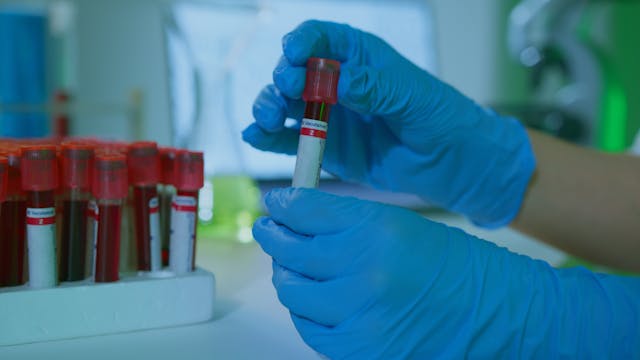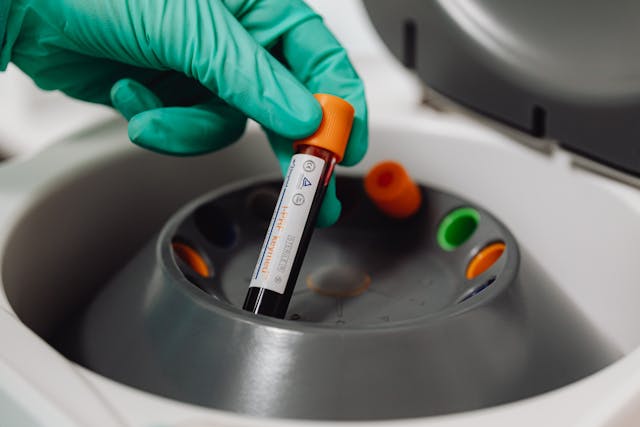Reaching the age of 100 used to be quite a rare achievement. Yet, nowadays, it seems to be a rather commonplace occurrence. Well, believe it or not, centenarians are not the fastest-growing demographic age group worldwide. Researchers in Sweden followed tens of thousands of people and analyzed routine blood tests taken years earlier. They then posed a question regarding the potential link between blood type and longevity. Do common lab markers hint at who reaches 100 years of age? The study revealed some of those common biomarkers, including glucose and cholesterol levels, in individuals who live past 90. The work has been published in a respected journal and made use of linked national registers; therefore, it draws on strong data. In this article, we will walk through what they measured and how they analyzed it.
The Study on Blood Type and Longevity

The team wanted to know whether simple blood tests, collected many years earlier, relate to exceptional longevity. Exceptional here means living to at least 100. They compared people who reached 100 with peers who did not. The participants all had their blood tests taken when they were about the same age. This is essential, since comparing a 70-year-old with a 90-year-old can confuse any signal. The study included standard markers of metabolism, kidney and liver function, iron status, and a measure tied to inflammation. The design used a long follow-up period, which would help to strengthen the conclusions. Participants were tracked for as long as 35 years after the first blood draw, using Swedish registers that record disease, deaths, and residence.
The authors put it plainly in their abstract: “Participants were followed in Swedish register data for up to 35 years.” We will return to the exact markers next, and then to the outcomes. For now, let’s focus on this specific core idea. The research does not claim that a single test guarantees a long life. It looks at patterns across a population and estimates the odds of reaching 100 for different ranges of each marker. That approach helps us see broader trends. It cannot tell exactly what will happen to one person. However, it can suggest where healthy targets may lie overall. It can also highlight which very low or very high values deserve attention. The analysis adjusted for age, sex, and a comorbidity index, which reduces some bias.
Which People were Involved in the Study?

The research used the AMORIS cohort. AMORIS is a population-based resource built from clinical laboratory testing in Stockholm County. It includes more than 800,000 people, but this study focused on 44,636 participants born between 1893 and 1920 who had blood tests between 1985 and 1996. Everyone was followed from the first test until death, or until the end of 2020. During follow-up, 1,224 people reached their 100th birthday. About 85% of the centenarians were women, which reflects broader survival patterns in Sweden at that time. The team linked the lab data to several national registers using Swedish personal identification numbers. That allowed accurate tracking of diseases and deaths. The analysis used descriptive statistics, logistic regression, and clustering.
Those methods helped compare distributions, estimate odds, and see whether centenarians formed distinct lab profiles. The authors note that “half of the participants were followed for more than 10 years,” which gives room for meaningful patterns to show up. They also adjusted their models for the Charlson Comorbidity Index, which summarizes serious health conditions from hospital records. This adjustment helps separate the lab signals from known disease burdens. The overall design is a strength. It reduces recall bias and uses consistent lab methods on fresh samples. The Swedish registers are internationally respected for completeness and quality control. However, not every lifestyle variable was available, and some desirable immune markers were missing.
Which Blood Markers were Studied?

The authors examined 12 routine blood markers. These included glucose and total cholesterol for metabolic status, creatinine for kidney function, liver enzymes (aspartate aminotransferase, gamma-glutamyl transferase, alkaline phosphatase, and lactate dehydrogenase), albumin for nutritional status, and iron plus total iron-binding capacity for anemia and iron handling. Uric acid was also measured, sometimes used as a marker associated with inflammation. This panel will feel familiar to anyone who has seen standard lab tests.
In the first version of the paper, the summary suggested that higher total cholesterol increased the odds of reaching 100. The authors later clarified: “Low cholesterol was associated with a reduced likelihood of reaching the age of 100,” while noting that “having high cholesterol neither increases nor decreases the probability of living to 100 years of age.”
The corrected guidance is more balanced, and it matches the figure that used the middle quintile as the reference. Their final message is specific. Belonging to the lowest quintiles of total cholesterol or iron was linked with lower odds of becoming a centenarian. Belonging to the highest quintiles of glucose, uric acid, GGT, ALP, LD, and TIBC was also linked with lower odds. For creatinine, the top two quintiles showed lower odds. For aspartate aminotransferase, both the highest and lowest quintiles showed lower odds. That U-shaped pattern can appear when both deficiency and excess carry risks. This nuance matters in clinic conversations. Pushing numbers to extremes can backfire. Health often lives in the middle. Your clinician reads lab values in context, including age, medications, diet, and current diseases. However, this population view still offers helpful direction for prevention.
More About Glucose

Glucose reflects how your body manages sugar. In this study, people with glucose values in the highest ranges had lower odds of reaching 100. That finding fits decades of research linking chronic hyperglycemia to vascular and nerve damage. It also aligns with diabetes care targets. The American Diabetes Association lists fasting plasma glucose under 100 mg/dL as normal. It defines 100 to 125 mg/dL as prediabetes, and 126 mg/dL or higher as diabetes. The study did not diagnose diabetes in a clinical way across the full cohort. It instead grouped people by quintiles of measured glucose and then estimated the odds of becoming a centenarian. Sustained high glucose tends to be associated with a higher disease risk. Therefore, aiming for healthy ranges makes sense for long-term health.
For people with diabetes, targets for premeal and after meal levels are set to reduce complications. For people without diabetes, routine screening helps catch rising values early. Talk with your clinician about your own results and context. Medications, acute illness, and meals can shift numbers in either direction. A single reading can never reveal all there is to know. However, if several readings trend high, then taking action is usually wise. Diet quality, physical activity, sleep, and stress support better control. Many small steps can add up when you keep them going. The study’s result does not say that extremely low glucose is a goal. Very low levels can be dangerous. It says that the highest quintile carried lower odds of reaching 100. Staying away from chronic hyperglycemia seems sensible, and that advice matches current standards of care.
Clues in the Liver and Kidneys

Creatinine is a waste product from muscles. Healthy kidneys filter it into the urine. When creatinine rises in the blood, it often signals reduced kidney function. In the Swedish analysis, people in the top two creatinine quintiles had lower odds of reaching 100. That fits the broader link between kidney health and survival. Mild reductions in kidney filtration can appear with age, dehydration, or medications. Persistent elevations deserve evaluation, since they may reflect chronic kidney disease. On the liver side, higher quintiles of enzymes like gamma-glutamyl transferase, alkaline phosphatase, and lactate dehydrogenase were tied to lower odds of exceptional longevity. These enzymes can rise with liver or bile duct problems, alcohol use, certain medications, or other conditions.
Doctors read these markers together, not in isolation. The study also noted a U-shaped link for aspartate aminotransferase. Both very high and very low values are related to lower odds. That pattern tells us extremes can be risky for different reasons. Very low values can track with frailty or poor nutrition in some settings. Very high values can reflect injury. The paper did not claim exact cutoffs for clinical decisions. It compared relative positions within the cohort. Yet it makes common sense. Kidneys and liver support many systems. Therefore, sustained signs of strain in those organs would not help a person reach advanced ages. If a recent panel shows changes, ask your clinician about repeat testing, medication review, alcohol intake, and imaging when appropriate. Small improvements in habits can move enzymes toward calmer ranges over time.
Uric Acid and Inflammation

Uric acid forms when the body breaks down purines. High levels can crystallize in joints and cause gout. They can also relate to kidney stones and kidney strain. In the Swedish results, a clear dose-response appeared. The lowest uric acid quintile had almost twice the chance of reaching 100 compared with the highest quintile. The authors also wrote that this difference “might point towards inflammation” influencing who reaches 100. That is a gentle hypothesis, not a definitive claim. Uric acid links to oxidative stress and metabolic disease, so lower values may signal a calmer internal environment. Still, there are caveats. Some people have high uric acid without gout or stones. Some drugs and diets can shift values up or down.
Therefore, your doctor will look at symptoms, kidney function, and medications before suggesting changes. If you have gout or stones, lowering uric acid is standard care. If you do not, the best steps are usually broad. Manage weight, limit alcohol, reduce sugar-sweetened drinks, and stay hydrated. These choices help uric acid and glucose together. The study also examined C-reactive protein in a subset. Low CRP linked with higher odds of reaching 100 in sensitivity analyses. That fits a large literature where lower chronic inflammation aligns with better outcomes in aging. However, CRP was not available for everyone, so we cannot lean too hard on that result here. Basically, markers tied to inflammatory processes seem calmer in those who eventually reach 100.
Cholesterol and Iron

Cholesterol often sparks debate. Low total cholesterol sat with a reduced likelihood of becoming a centenarian in this cohort. High total cholesterol did not raise or lower the odds of reaching 100. That does not mean high cholesterol is safe for your heart. It means this longevity analysis, using odds across quintiles, did not find a simple linear benefit from pushing total cholesterol downward. Context is everything. Heart disease prevention focuses on LDL cholesterol, not total cholesterol alone. National guidance still targets healthy LDL levels, because LDL drives plaque formation. The CDC lists an optimal LDL near 100 mg/dL for most adults, with total cholesterol near 150 mg/dL as a population goal.
Any single number sits within a much bigger risk picture. Iron also showed nuance. Very low iron is related to lower odds of reaching 100. Low iron can reflect anemia, chronic disease, or poor nutrition. Again, extremes bring problems. Too little iron can cause fatigue and reduced exercise tolerance. Too much iron can actually harm your organs. The best approach is not to chase very low totals or very low iron. It is to keep values in healthy ranges based on your age, sex, and medical history. Your clinician can separate total cholesterol, LDL, HDL, and triglycerides and then set a plan. That plan may involve diet, exercise, and sometimes medication. For iron, the plan could include looking for blood loss, improving diet quality, or treating specific causes. The Swedish data encourage moderation and careful context over one-number obsession.
What Can You Do?

Now let’s make this practical. If you have a recent lab panel, review it with your clinician. Ask them about glucose, kidney function, liver enzymes, iron status, and cholesterol types. If glucose trends high, discuss diet quality, weight goals, movement, sleep, and stress. The ADA offers clear ranges for diagnosis and treatment targets. For kidney function, creatinine guides estimates of filtration. MedlinePlus explains this in simple terms, and those resources can help you prepare for visits. On the liver side, persistently high enzymes deserve a plan. That plan may include looking at alcohol intake, medications, viral testing, and metabolic health.
For uric acid, stay well-hydrated and limit sugary drinks. If you have gout or kidney stones, your clinician may recommend medication. For iron, be aware of symptoms and possible causes: low iron can result from menstrual blood loss, gastrointestinal bleeding, or insufficient intake, while high iron may come from genetic factors or over-supplementation.
Cholesterol should always be considered in context. Work with your healthcare team to manage LDL and overall cardiovascular risk. The CDC provides helpful guidance on target ranges. Avoid chasing very low cholesterol without medical reason, and do not ignore high LDL. A moderate, steady approach is usually best.
This Swedish study suggests that extreme values—particularly high glucose and liver enzyme levels—are linked with lower odds of exceptional longevity. Maintaining calm, steady ranges supports long-term resilience. Small, consistent lifestyle changes are easier to sustain and tend to improve multiple health markers at once.
Disclaimer: This information is not intended to be a substitute for professional medical advice, diagnosis or treatment and is for information only. Always seek the advice of your physician or another qualified health provider with any questions about your medical condition and/or current medication. Do not disregard professional medical advice or delay seeking advice or treatment because of something you have read here.

